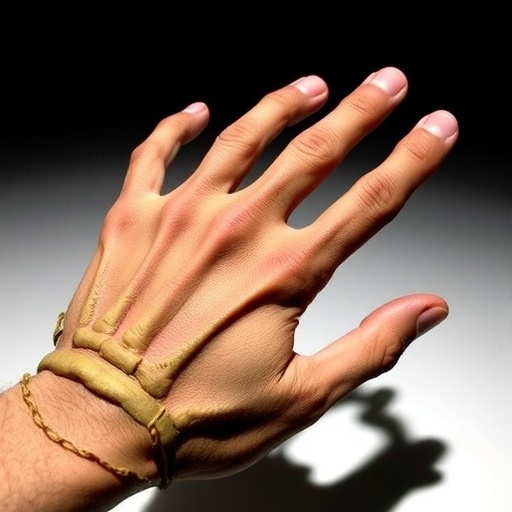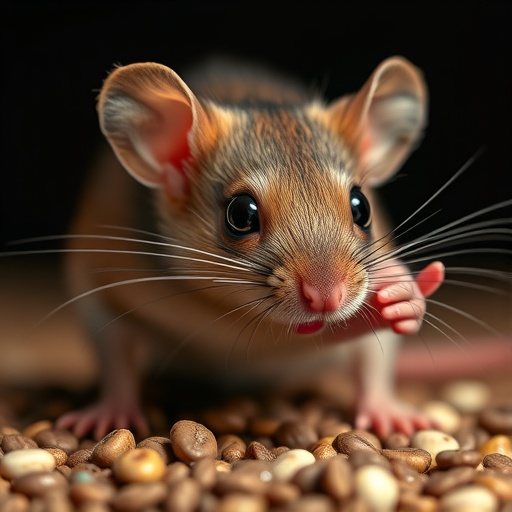In a groundbreaking study published in Nature, researchers have unveiled new fossil evidence shedding unprecedented light on the hand anatomy of Paranthropus boisei, one of our enigmatic hominin relatives. The fossils, curated under specimen number KNM-ER 101000, represent some of the most complete hand elements attributed to this species, allowing scientists to delve deeper into its evolutionary implications and functional morphology. This monumental discovery challenges prevailing interpretations of robust australopith adaptations and offers fresh perspectives on the manipulative capabilities of early hominins.
The research team employed cutting-edge 3D surface scanning and micro-computed tomography (microCT) to digitize and analyze the fossilized hand bones with remarkable precision. Using a HDI Advance 3D scanner, T. Gichunge conducted meticulous surface scans immediately following excavation and specimen preparation. Subsequently, microCT scanning was completed at Stellenbosch University’s CT Scanner Facility, leveraging a General Electric Phoenix VTOMEX L240 to achieve scan resolutions between 15 and 50 microns. These high-resolution imaging techniques facilitated detailed visualization of internal and external bone structures, crucial for interpreting morphological nuances.
A significant focus was placed on dental metrics, specifically enamel thickness and crown morphology of maxillary and mandibular molars. The unworn third molars (RM3) were virtually sectioned at the enamel-dentine junction (EDJ) using Avizo software, revealing precise enamel cap areas. Despite minor fractures in the enamel caps, the researchers employed innovative correction methodologies, including curvature-based estimations, to compute average enamel thickness (AET)—critical for contextualizing dietary adaptations within the Paranthropus lineage. These enamel measurements, combined with linear dental dimensions gathered via high-accuracy dial calipers, were compared against extensive hominin dental datasets to establish functional affinity.
Beyond dental analysis, the hand skeletal anatomy was subjected to comprehensive morphometric scrutiny. Measurements spanning metacarpals and phalanges were systematically recorded and benchmarked against both extant primate taxa and fossil hominin specimens. Notably, the partial preservation of the first manual proximal phalanx (mPP1) necessitated an innovative estimation of its total length. By leveraging robust correlations evident in extant Homo sapiens, Pan, and Gorilla samples, a least squares regression model guided the extrapolation of missing phalangeal dimensions. This approach underscored the integration of comparative anatomy and statistical modeling in paleoanthropological reconstructions.
The first metacarpal’s proximal articular surface was analyzed through principal curvature quantification in dorsopalmar and radioulnar directions. A quadric surface fit revealed curvature values indicative of saddle-shaped morphology consistent with hominid adaptations for manual dexterity. The curvature parameters were rigorously compared with those of extant and fossil taxa, elucidating evolutionary trends in carpal-metacarpal joint shape aimed at manipulative function and load distribution.
In parallel, canonical variate analyses unraveled the shape configurations of key carpal bones, including the trapezoid, scaphoid, and lunate. The trapezoid facet geometry was characterized by angular relations between articular surfaces and normalized surface area ratios, drawing on least-squares planar approximations. For the scaphoid, an advanced 3D geometric morphometric framework was employed, combining a dense array of landmarks and sliding semi-landmarks to capture subtle shape variations. Subsequent Procrustes alignment and principal component analyses distilled the morphological signal, situating KNM-ER 101000 within the broader spectrum of hominoid wrist morphology.
Integration of scaphoid and lunate shapes in matched pairs further refined the functional narrative of midcarpal joint evolution in Paranthropus. This combined analysis revealed nuanced variations in joint congruency and mobility potentials that are tightly linked to locomotor and manipulative behaviors. Meanwhile, the hamate’s biomechanical form was quantified through landmark-based variables reflecting grasping mechanics, highlighting adaptations pertinent to tool-use and forceful prehension.
The forearm morphology, particularly the radius’ cross-sectional geometry, was also scrutinized. Cortical area measurements taken at the 25% physiological length mark provided comparative insights into biomechanical loading regimes among hominins and extant apes. Utilizing CT scans of modern human, chimpanzee, and gorilla radii, segmented images analyzed via BoneJ in ImageJ software facilitated rigorous evaluation of cortical robustness, an indicator of habitual manual function and mechanical stress adaptation.
Furthermore, pedal traits were analyzed with equal rigor to infer locomotor patterns. The hallux proximal phalanx, a critical element for bipedal stability and grasping, was digitally reconstructed from diverse CT imaging repositories and scanned datasets. Parameters such as dorsal canting angle—the inclination between the proximal articular surface and the plantar base plane—were calculated to compare Paranthropus foot morphology with extant primates. Length ratios among pedal phalanges and curvature measurements informed on foot biomechanics, suggesting degrees of arboreal versus terrestrial adaptation.
The third metatarsal’s torsion angle was meticulously quantified through a novel 3D landmark-based method integrating six anatomically defined points to establish local coordinate axes. This enabled precise calculation of torsional rotation at the tarsometatarsal joint, critical for understanding midfoot rigidity and propulsion mechanics. Comparative analysis against multiple hominin and primate taxa placed KNM-ER 101000 within a functional continuum reflecting locomotive evolution.
Complementing morphological assessments, ancestral state reconstruction employed a discrete character matrix encompassing 20 key manual traits. By coding these characters across six extant species and 14 fossil taxa, and applying maximum parsimony on a robust phylogenetic topology, the research delineated the evolutionary trajectory of manual adaptations. This phylogenetic approach illuminated the emergence of derived traits within Paranthropus and their divergence relative to both earlier and contemporary hominins.
The comprehensive fusion of high-resolution imaging, morphometric sophistication, and phylogenetic inference established a compelling narrative: the Paranthropus boisei hand displays a mosaic of primitive and derived traits, resonating with increased manipulative capabilities previously underestimated in this robust australopith. These findings have profound implications for interpreting the ecological niches occupied by Paranthropus and reconsidering their role within hominin adaptive landscapes.
This research heralds a paradigm shift, emphasizing the importance of hand functionality in defining hominin evolutionary pathways beyond cranio-dental adaptations alone. As the most complete hand material attributed to Paranthropus boisei to date, the KNM-ER 101000 specimen provides an unparalleled window into the morphology that accompanied dietary, locomotive, and potentially technological innovations during a critical juncture in human evolution.
By merging advanced imaging modalities, geometric morphometrics, and evolutionary modeling, the study not only refines the morphological repertoire associated with Paranthropus but also sets a new standard for integrating fossil evidence into functional and evolutionary discourse. Future excavation and analytical endeavors may build upon this framework, enriching our understanding of hominin diversity and the origins of human manual dexterity.
Subject of Research:
New fossil hand anatomy of Paranthropus boisei elucidating manual functional morphology and evolutionary adaptations.
Article Title:
New fossils reveal the hand of Paranthropus boisei.
Article References:
Mongle, C.S., Orr, C.M., Tocheri, M.W. et al. New fossils reveal the hand of Paranthropus boisei. Nature (2025). https://doi.org/10.1038/s41586-025-09594-8
Image Credits: AI Generated
Tags: 3D surface scanning technologyaustralopith adaptationscrown morphology of molarsdental metrics in fossilsenamel thickness analysisfunctional morphology of early homininshigh-resolution imaging techniqueshominin evolutionmicro-computed tomography in paleontologynew fossil discoveriesParanthropus boisei hand anatomysignificance of fossil evidence





